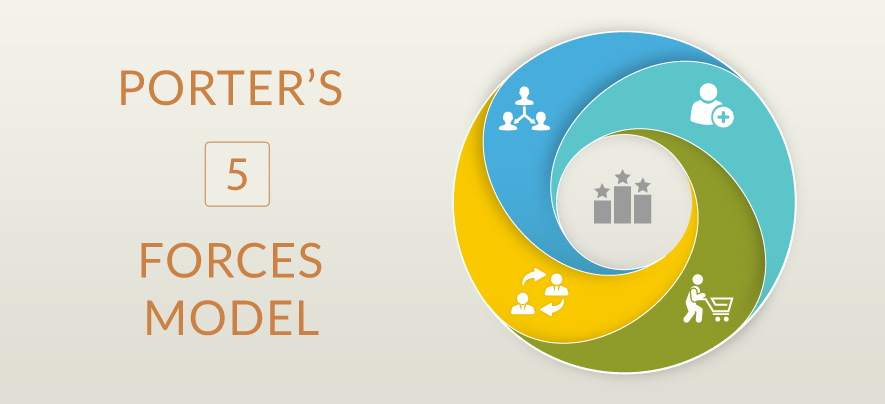Porter’s Model – 5 Forces that May Impact SME Business Strategy
Business Development
504 week ago — 7 min read
A business owner will be acutely aware that there are many forces that act on her/his industry. An appreciation of these forces, and an understanding of which of these act on your particular industry and is likely to impact you more is the key.
Michael Porter has classified these into 5 categories – and created a framework called the 5 forces.
These five forces are
- Bargaining Power Of Buyers
- Bargaining Power Of Suppliers
- Threat Of Competition
- Threat Of Substitutes
- Threat of New Entrants
- Bargaining power of buyers
Bargaining power of buyers is often obvious, and sometimes not. A big buyer has higher bargaining power and can dictate her/his terms. A well-known consumer products company, by its sheer width of products, high volumes and frequent product launches had the top 4 Advertising Agencies in India scampering to get its business and bending backwards to service it. They even set up dedicated teams just to service this client. That was a classic example of great bargaining power of the buyer.
However, the bargaining power of buyers is not restricted to size alone. A buyer that gives huge business has high bargaining power and gets excellent credit periods from its suppliers. On the other hand, its rival, which has relatively lower volumes, can increase its bargaining power by ensuring very timely payments, as against the larger rival. Remaining loyal to one supplier can also increase your bargaining power - while in sharp contrast, the larger company increases its bargaining power by going to multiple vendors.
However, when Porter created this model, what he was referring to really was how a company evaluated its decision to enter an industry by looking at the Bargaining Power of consumers. In some industries, the consumer bargaining power is high – whereas in others, it is low. Real estate in Mumbai, for instance, could be considered an industry where the bargaining power of buyers is low. There could come a time, when flats are going a-begging – at such times, the bargaining power of buyers increases. - Bargaining power of suppliers
Some companies that supply raw materials to an industry are very dependent on the buyers. On the other hand, there are some who may either have a patent or own a technology that gives them a high bargaining power.
For a company to evaluate the entry into that industry, it would look at whether that industry is dependent on a few suppliers. The shipping industry for instance was at one time, dependant on a handful of suppliers who manufactured anti-corrosive pumps. So the supplier bargaining power was high. However, one would not take a decision to avoid entering this industry for just this one reason. And therefore, the point being made is that, each of these 5 forces is not considered in isolation, but as a whole.
When there were a few Aloe Vera plant growers in India, and the pharmaceutical industry was clamouring for the sap – the bargaining power of suppliers was high. This in turn led to the industry becoming attractive and many people set up their Aloe Vera plantations. Soon the bargaining power of these suppliers reduced – but not drastically. -
Threat of competition
Every industry has competitors. Whether the competition is healthy and whether it is fair is an important consideration. Is an industry highly fragmented? Or does it have only a couple of players? A business person will look at all these factors and then make her/his choices. Greater the competition, more the excitement, higher the likelihood of getting more vendors and higher the likelihood of the industry being towards a stage of maturity. The exception to this is when an industry goes through a wave – such as the dotcom wave, where the industry in its infancy itself starts attracting many competitors. In such vases a shakeout is inevitable – market forces, if not the customers, manage to separate the wheat from the chaff!
- Threat Of Substitutes
This one is an important one but also difficult to predict! Entire industries get wiped out or replaced thanks to a substitute product. It is important that the business person keep a ear to the ground to see these changes coming.
It isn’t a case where something happens overnight – nothing so sweeping really does. It is only the effect of all the tiny events that happen over time, that we see overnight. We notice effects like one industry giant adopting a new technology, followed by other Industry giants doing the same. Suddenly the world wakes up and believes that this change happened overnight. The reality is that the company probably spent years or months on R&D, and a lot of time in their go to market activities. It is the effect of all these efforts that could seem to happen overnight. However, all industries might not have the high gestations mentioned earlier – some would have shorter gestations. But there is a gestation.
The question being addressed really, is can one anticipate a possibility of a substitute. The answer is a yes and no. Yes, one can sense winds of change or even consumer dissatisfaction. Disruptive innovations or technologies may be harder to anticipate. Just as it requires a creative mind to think of a new product, it requires a creative mind to be able to see possibilities where there seem none. Sudden purchase of a raw material, intrusive or discreet queries about your products and processes, a casual consumer remark should set the antennae on alert. This does not happen. We are so busy immersed in our day to day problems that, we tend to get complacent. And complacence can be the number one enemy.
The big question remains – can we anticipate the threat of a substitute product? As an answer - we may not be able to anticipate the impending threat of a substitute, but we could counter it. -
Threat of new entrants
Many industries, especially in their early stages are quite likely to have new entrants. At this stage, chances are that there is room enough for everyone. Because the market hasn’t been tapped completely, and our own business isn’t threatened, we accept the inevitability of a new entrant. We may even tend to brush it aside by rationalizing that our idea, service delivery, business model etc. is better.
The likelihood of new entrants in a mature industry is lower. However, the impact can be significant. A new entrant in a relatively mature industry comes in with a purpose and with specific knowledge. In all likelihood, they have had commitments from a client – and this also implies that there lies a dissatisfied or amorous client.
We would love to hear from you about what you think one can do to counter these threats. We will share some of our own views too.
Posted by
GlobalLinker StaffWe are a team of experienced industry professionals committed to sharing our knowledge and skills with small & medium enterprises.
View GlobalLinker 's profile
Most read this week















Comments
Share this content
Please login or Register to join the discussion